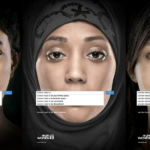“We scammed people to save them.”
A week ago, Bollywood dancer Nora Fatehi took to Instagram to express shock and anger over the brand Lulumelon using her deepfake for their promotions. “Shocked! THIS IS NOT ME”, she wrote, addressing the way the brand advertised a nearly “100% off” end-of-the-season sale with a video featuring Fatehi’s deepfake.
However, there was a twist. This entire episode was a charade, and viewers soon realized that it was actually a collaboration between Faheti and HDFC, who added it to their new ‘What the Fraud‘ campaign series.
What the Fraud by HDFC aims to build awareness about financial fraud. Featuring “Vigil Aunty”, a superhero played by a saree-adorned woman who fights back against financial crimes, its latest episode features Nora Fatehi and Vigil Aunty discussing the rising prominence of deepfakes across India. Their conversation was an insightful perspective into the current state of the advertising world, breaking down the potent and menacing threat that AI poses to consumers at large.
View this post on Instagram
Soon, viewers understood the depth of the prank. ‘Lulumelon’, the brand responsible for deepfading Fatehi, was actually just as HDFC creation that was shared across social media to provoke interest and outrage from audiences. HDFC cleverly mimicked the tactics used by duplicitous entities by using AI to make Vigil Aunty resemble Nora Faheti in both appearance and voice, obtaining her consent for doing so.
That’s not all. To create even more widespread awareness among consumers, HDFC created and promoted multiple fake social media accounts and website domains (lulumelon.sk, lulumelon.in, etc), which mirrored the characteristics of deceitful deepfake schemes. However, when curious viewers and shoppers visited those websites, they were met with a surprise: Nora Faheti
In a bid to elevate the deception, HDFC created multiple social media handles and diverse website domains like lulumelon.in, lulumelon.sk, all built to emulate the online characteristics of fraudulent schemes and to make the whole schtick stand out. It was only when people visited these websites, that the whole thing was explained to them. Nora exposed the fraudulent nature of these kinds of promotions and disowned the pictures and videos of herself online.
Thus, this campaign flawlessly depicted the illusionary nature of “too good to be true” campaigns and financial schemes, making it a much-needed call to action about the evolving threats in our cyberspace.



